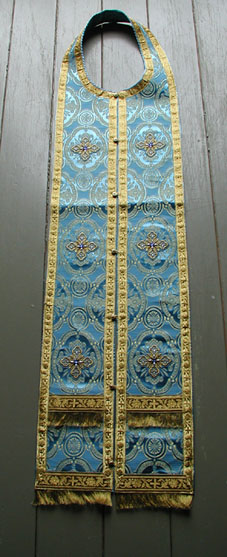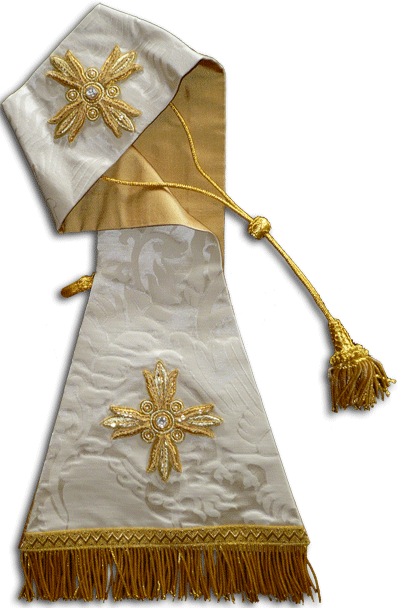|
Epimanikia
Epimanikia (singular ''epimanikion'') are liturgical vestments of the Eastern Orthodox Church and Eastern Catholic Churches. They are cuffs (Russian: ''porútchi'') made of thickened fabric, usually brocade, that lace onto the wrists of a bishop, priest, or deacon. There is usually a cross embroidered or appliquéd to the center. Bishops and priests attach the epimanikia to the sleeves of the sticharion. Since the deacon wears a more elaborate sticharion as an outer garment, its large winged sleeves are not bound by epimanikia; rather he wears the epimanikia underneath, tied to his ''endorrason'' ( inner cassock) (Russian: подрясник, ''podryasnik'') Among most ethnic groups, the epimanikia will be worn by bishops and priests only when they vest fully for the Divine Liturgy. However, among stricter Russian Orthodox clergy a bishop or priest will wear the epimanikia any time he wears the epitrachelion. Deacons always wear the epimanikia whenever they vest. In the Armenia ... [...More Info...] [...Related Items...] OR: [Wikipedia] [Google] [Baidu] |
Sticharion
The sticharion (also ''stikharion'' or ''stichar''; Greek: στιχάριον; Slavonic: стихарь) is a liturgical vestment of the Eastern Orthodox and Eastern Catholic Churches, roughly analogous in function to the alb of the Western Church. The sticharion is worn by all classes of ordained ministers in the Constantinopolitan Rite and comes in two forms: one worn by priests and one worn by deacons and other altar servers. The sticharion is derived from the '' chiton'', a long, sleeved garment which reached to the ground and was worn in ancient times by both men and women. Deacons and Servers In the form worn by deacons, subdeacons, altar servers, and sometimes by readers, the sticharion is a long robe with wide, loose sleeves, fastened at the neck, and often open down the sides but held shut with buttons or ties. Thus in form, it is close to the dalmatic and tunicle of Western Christianity. There is usually a cross embroidered or appliquéd to the center of the back, be ... [...More Info...] [...Related Items...] OR: [Wikipedia] [Google] [Baidu] |
Vestment
Vestments are liturgical garments and articles associated primarily with the Christian religion, especially by Eastern Churches, Catholics (of all rites), Anglicans, and Lutherans. Many other groups also make use of liturgical garments; this was a point of controversy in the Protestant Reformation and sometimes since, in particular during the ritualist controversies in England in the 19th century. Origins of vestments In the early Christian churches, officers and leaders, like their congregations, wore the normal dress of civil life in the Greco-Roman world, although with an expectation that the clothing should be clean and pure during holy observances. From the 4th century onward, however, modifications began to be made to the form of the garments, and as secular fashions changed from the 6th century the church retained the original forms of their garments, although with separate development and with regional variations. Having separate, consecrated clothing for the cere ... [...More Info...] [...Related Items...] OR: [Wikipedia] [Google] [Baidu] |
Epitrachelion
The ''epitrachelion'' ( grc-gre, ἐπιτραχήλιον "around the neck"; Slavic: епитрахиль, ''epitrachil''; often called simply a '' stole'' in casual English-language usage) is the liturgical vestment worn by priests and bishops of the Orthodox Church and Eastern Catholic Churches as the symbol of their priesthood, corresponding to the Western stole. It is essentially the ''orarion'' adapted for priests and bishops, worn around the neck with two ends of equal length hanging down in front of the clergyman's body (more or less to the ankle) and with the two adjacent sides sewn or buttoned together up the center, leaving enough space through which to place the head. In practice, the ''epitrachelion'' is made to be worn only this way, tailored to lie flat around the neck, and is never actually unfastened. The portion hanging down in front is sometimes even a solid piece of fabric. It is usually made of brocade with seven embroidered or appliquéd crosses, one at ... [...More Info...] [...Related Items...] OR: [Wikipedia] [Google] [Baidu] |
Priest
A priest is a religious leader authorized to perform the sacred rituals of a religion, especially as a mediatory agent between humans and one or more deities. They also have the authority or power to administer religious rites; in particular, rites of sacrifice to, and propitiation of, a deity or deities. Their office or position is the 'priesthood', a term which also may apply to such persons collectively. A priest may have the duty to hear confessions periodically, give marriage counseling, provide prenuptial counseling, give spiritual direction, teach catechism, or visit those confined indoors, such as the sick in hospitals and nursing homes. Description According to the trifunctional hypothesis of prehistoric Proto-Indo-European society, priests have existed since the earliest of times and in the simplest societies, most likely as a result of agricultural surplus and consequent social stratification. The necessity to read sacred texts and keep temple or church rec ... [...More Info...] [...Related Items...] OR: [Wikipedia] [Google] [Baidu] |
Deacon
A deacon is a member of the diaconate, an office in Christian churches that is generally associated with service of some kind, but which varies among theological and denominational traditions. Major Christian churches, such as the Catholic Church, the Oriental Orthodox Churches, the Eastern Orthodox Church, the Scandinavian Lutheran Churches, the Methodist Churches, the Anglican Communion, and the Free Church of England, view the diaconate as an order of ministry. Origin and development The word ''deacon'' is derived from the Greek word (), which is a standard ancient Greek word meaning "servant", "waiting-man", "minister", or "messenger". It is generally assumed that the office of deacon originated in the selection of seven men by the apostles, among them Stephen, to assist with the charitable work of the early church as recorded in Acts of the Apostles chapter 6. The title ''deaconess'' ( grc, διακόνισσα, diakónissa, label=none) is not found in the Bible. Ho ... [...More Info...] [...Related Items...] OR: [Wikipedia] [Google] [Baidu] |
Maniple (vestment)
The maniple is a liturgical vestment used primarily within the Catholic Church, and occasionally used by some Anglo-Catholic and Lutheran clergy. It is an embroidered band of silk or similar fabric that is hung over the left arm. It is only used within the context of the Mass, and it is of the same liturgical colour as the other Mass vestments. The purpose of the maniple is uncertain, but it probably originated as a cloth the priest could use to wipe his hands and face. Current use In its 1967 instruction, ''Tres abhinc annos'', issued while the Tridentine Mass was still the only form used in the Roman Rite, the Sacred Congregation of Rites removed the obligation to use the maniple at Mass. Thereafter, the maniple generally fell out of liturgical use. It is still required to be worn by those who, as authorized by Pope Benedict XVI's 2007 ''motu proprio'' ''Summorum Pontificum'', use the 1962 edition of the Roman Missal. As Mauro Gagliardi, a consultor to the office for the Pope ... [...More Info...] [...Related Items...] OR: [Wikipedia] [Google] [Baidu] |
Syriac Orthodox Church
, native_name_lang = syc , image = St_George_Syriac_orthodox_church_in_Damascus.jpg , imagewidth = 250 , alt = Cathedral of Saint George , caption = Cathedral of Saint George, Damascus, Syria , type = Church of Antioch, Antiochian , main_classification = Eastern Christianity, Eastern Christian , orientation = Oriental Orthodoxy, Oriental Orthodox , scripture = Peshitta , theology = Miaphysitism , polity = Episcopal polity, Episcopal , structure = Koinonia, Communion , leader_title = Patriarch , leader_name = Ignatius Aphrem II Syriac Orthodox Patriarch of Antioch and All the East, Patriarch , fellowships_type = Catholicos of India, Catholicate of India , fellowships = Malankara Syriac Orthodox Church , associations = World Council of Churches , area = Middle East, India, and Assyrian–Chaldean� ... [...More Info...] [...Related Items...] OR: [Wikipedia] [Google] [Baidu] |
Byzantine Empire
The Byzantine Empire, also referred to as the Eastern Roman Empire or Byzantium, was the continuation of the Roman Empire primarily in its eastern provinces during Late Antiquity and the Middle Ages, when its capital city was Constantinople. It survived the fragmentation and fall of the Western Roman Empire in the 5th century AD and continued to exist for an additional thousand years until the fall of Constantinople to the Ottoman Empire in 1453. During most of its existence, the empire remained the most powerful economic, cultural, and military force in Europe. The terms "Byzantine Empire" and "Eastern Roman Empire" were coined after the end of the realm; its citizens continued to refer to their empire as the Roman Empire, and to themselves as Romans—a term which Greeks continued to use for themselves into Ottoman times. Although the Roman state continued and its traditions were maintained, modern historians prefer to differentiate the Byzantine Empire from Ancient Rome ... [...More Info...] [...Related Items...] OR: [Wikipedia] [Google] [Baidu] |
Cassock
The cassock or soutane is a Christian clerical clothing coat used by the clergy and male religious of the Oriental Orthodox Churches, Eastern Orthodox Church and the Catholic Church, in addition to some clergy in certain Protestant denominations such as Anglicans and Lutherans. "Ankle-length garment" is the literal meaning of the corresponding Latin term, . It is related to the habits traditionally worn by nuns, monks, and friars. The cassock derives historically from the tunic of classical antiquity that in ancient Rome was worn underneath the toga and the chiton that was worn beneath the himation in ancient Greece. In religious services, it has traditionally been worn underneath vestments, such as the alb. In the West, the cassock is little used today except for religious services, save for traditionalist and those other Catholic clergy and religious who continue to wear the cassock as their standard attire. However, in many countries it was the normal everyday wear ... [...More Info...] [...Related Items...] OR: [Wikipedia] [Google] [Baidu] |
Appliqué
Appliqué is ornamental needlework in which pieces or patches of fabric in different shapes and patterns are sewn or stuck onto a larger piece to form a picture or pattern. It is commonly used as decoration, especially on garments. The technique is accomplished either by hand stitching or machine. Appliqué is commonly practised with textiles, but the term may be applied to similar techniques used on different materials. In the context of ceramics, for example, an appliqué is a separate piece of clay added to the primary work, generally for the purpose of decoration. The term originates from the Latin ''applicō'' "I apply" and subsequently from the French ''appliquer'' "attach". History The term appliqué is derived from French and Latin verbs ''appliquer'' and ''applicare'', respectively, which both mean to join or attach. Like embroidery, it has a humble beginning. The technique was used as a way to strengthen worn areas of items or to patch holes that had formed. Early ap ... [...More Info...] [...Related Items...] OR: [Wikipedia] [Google] [Baidu] |








